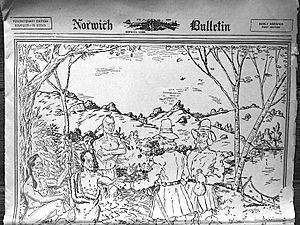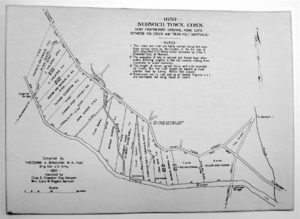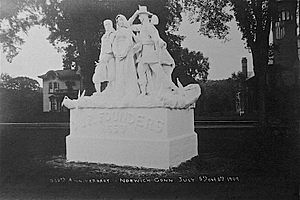Norwichtown facts for kids
Quick facts for kids |
|
|
Norwichtown Historic District
|
|

Old School House
|
|
| Location | Roughly bounded by Huntington Ln., Scotland Rd., and Washington, Town and E. Town Sts., Norwich, Connecticut |
|---|---|
| Area | 110 acres (45 ha) |
| Architect | Multiple |
| Architectural style | Colonial, Georgian |
| NRHP reference No. | 73001951 |
| Added to NRHP | January 17, 1973 |
Norwichtown is a very old neighborhood in Norwich, Connecticut. It's located just north of the Yantic River. This area is special because it was the first place where Norwich was settled way back in 1659!
A big part of Norwichtown, especially around the Norwichtown Green, is a protected historic district. It was added to the National Register of Historic Places in 1973. This means it's recognized as an important historical area. The district covers about 110 acres and includes 48 important old buildings.
Contents
The Story of Norwichtown
Norwich was first settled in 1659 by 35 English settlers. They moved from Saybrook Fort and were led by Major John Mason. They bought land from Uncas, who was the leader of the Mohegans (a Native American tribe). The very first settlement was built around what is now the Norwichtown Green.
The Norwichtown Green and Its Surroundings
The Norwichtown Green is a triangular park, about 1.75 acres in size. It's surrounded by old trees and streets like Town Street and East Town Street. Many 18th and 19th-century houses and shops line these streets, facing the Green.
Some of the oldest houses in Norwichtown were built in the 1600s!
- The Bradford-Huntington House was built around 1660.
- The Olmstead-Lathrop House dates back to between 1659 and 1745.
- The Leffingwell House Museum was built around 1675.
- The Simon Huntington House was built around 1690.
The First Congregational Church, built in 1801, was the third church building for the local community. Many old homes in the area have been turned into businesses today. The John Mason School, for example, is now the main office for the Norwich Public School System.
North of the first schoolhouse, you'll find the Colonial Cemetery. Four Connecticut governors are buried here! Also, north of the Green is Meeting House Hill, a large cliff. This spot was used as a lookout point, and the village's second and third meetinghouses were built there.
Important Historic Buildings
Five buildings within the Norwichtown Historic District are so important that they are listed separately on the National Register of Historic Places.
- The Leffingwell Inn is a unique saltbox-style house.
- The Joseph Carpenter Silversmith Shop was built around 1772-1774.
- The Dr. Daniel Lathrop School dates to 1782 and is one of Connecticut's oldest brick schoolhouses.
- The Bradford-Huntington House is at 16 Huntington Lane.
- The Gen. Jedidiah Huntington House is at 23 E. Town Street.
Norwichtown's Changing Role
Norwichtown was the original center of Norwich when it was mostly a farming community in the late 1600s. But by the early 1700s, the focus shifted to the harbor area in the nearby Chelsea neighborhood. This new area became the main "center" of Norwich, with factories and businesses.
Because of this, the old town center became known as 'Norwichtown' to tell it apart from the newer city center. In 1952, the city and town of Norwich officially joined together. Norwichtown then became a residential neighborhood within the larger city.
Famous Residents and Landmarks
Samuel Huntington was a very important person who lived in Norwichtown. He signed the Declaration of Independence, was president of the Continental Congress, and even the first President of the United States under the Articles of Confederation. He also served as governor of Connecticut. His house is east of the Green, and he is buried in the Old Norwichtown Burying Ground. Samuel Huntington Elementary School in Norwichtown is named after him.
The Leffingwell Inn is one of the most famous historic homes in Norwich. Stephen Backus built the original house in 1675. In 1700, Thomas Leffingwell 2nd bought it and turned it into an inn. The Tavern Hall, to the right of the entrance, is the oldest part of the house. It has one of the few remaining fully paneled rooms from that century. The inn also displays beautiful works from Norwich silversmiths and clockmakers from the 1700s. It's even said that George Washington ate breakfast at the Leffingwell Inn in 1776!
Norwichtown Historic District Details
The Norwichtown Historic District was officially listed on the National Register of Historic Places (NRHP) in 1973. It was already a local historic district before that. The local historic commission wanted it listed on the national register to give it more recognition and status.
The district includes much of the original settlement area of Norwich. It covers the Norwichtown Green and the Old Norwichtown Burying Ground. The district has an interesting shape, spreading out along the streets that lead from the Green. It includes the Green and stretches down to the Leffingwell museum. There's also a smaller, separate part with six buildings on Harland Road.
The district covers 110 acres and has 48 buildings that contribute to its historical importance, plus one other historical site. It was designed to exclude newer commercial areas like the Norwichtown Mall.
Two "outstanding" buildings in the district are the Dr. Daniel Lathrop School and the Joseph Carpenter Silversmith Shop. Both are located on the Norwichtown Green. The school, built in 1783, is thought to be one of the oldest brick schoolhouses still standing in Connecticut.
Five buildings in the district are so important that they are listed separately on the NRHP:
- The Bradford-Huntington House at 16 Huntington Lane.
- The Joseph Carpenter Silversmith Shop at 71 E. Town Street.
- The 1798 East District School at 365 Washington Street.
- The Gen. Jedidiah Huntington House at 23 E. Town Street.
- The Leffingwell Inn at 348 Washington Street.
Washington Street, a main road, has many homes built before 1800. Even after more than 300 years, the way Norwichtown is laid out still looks similar to its original 1660 settlement.
Images for kids












